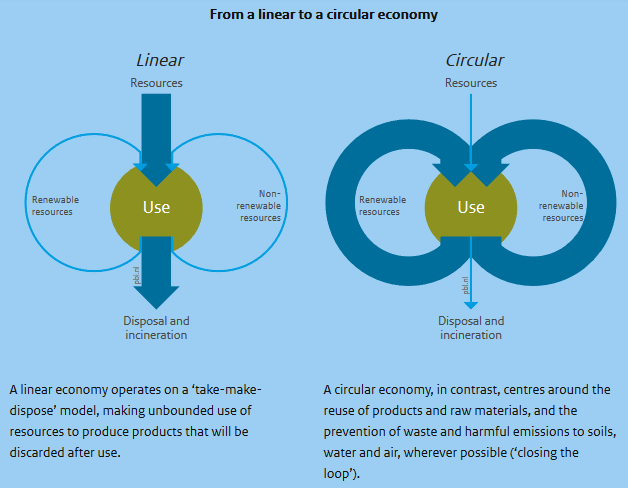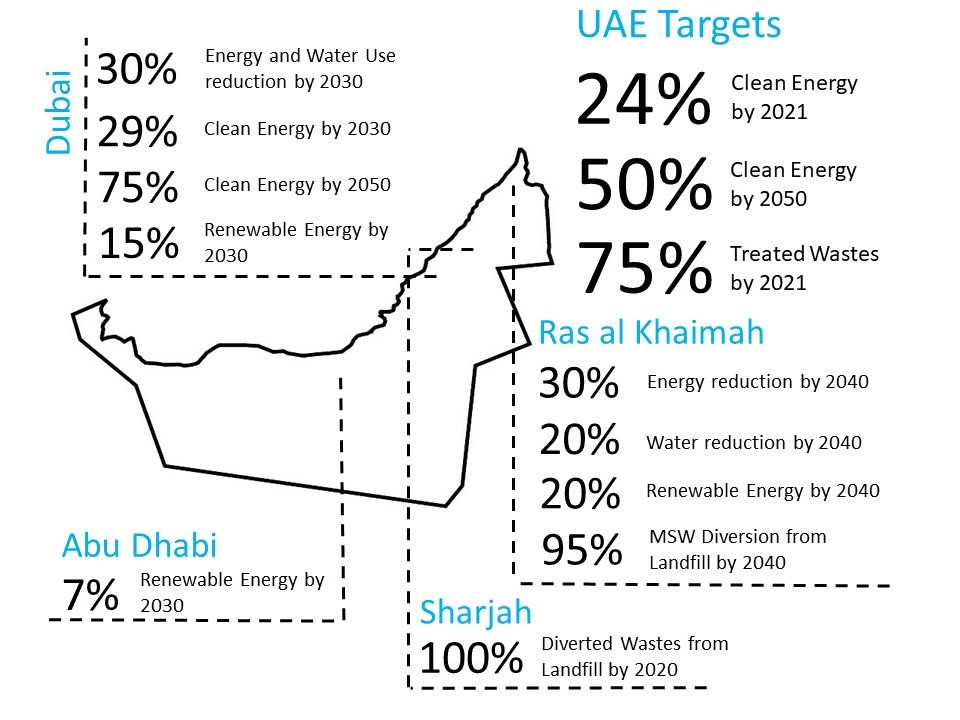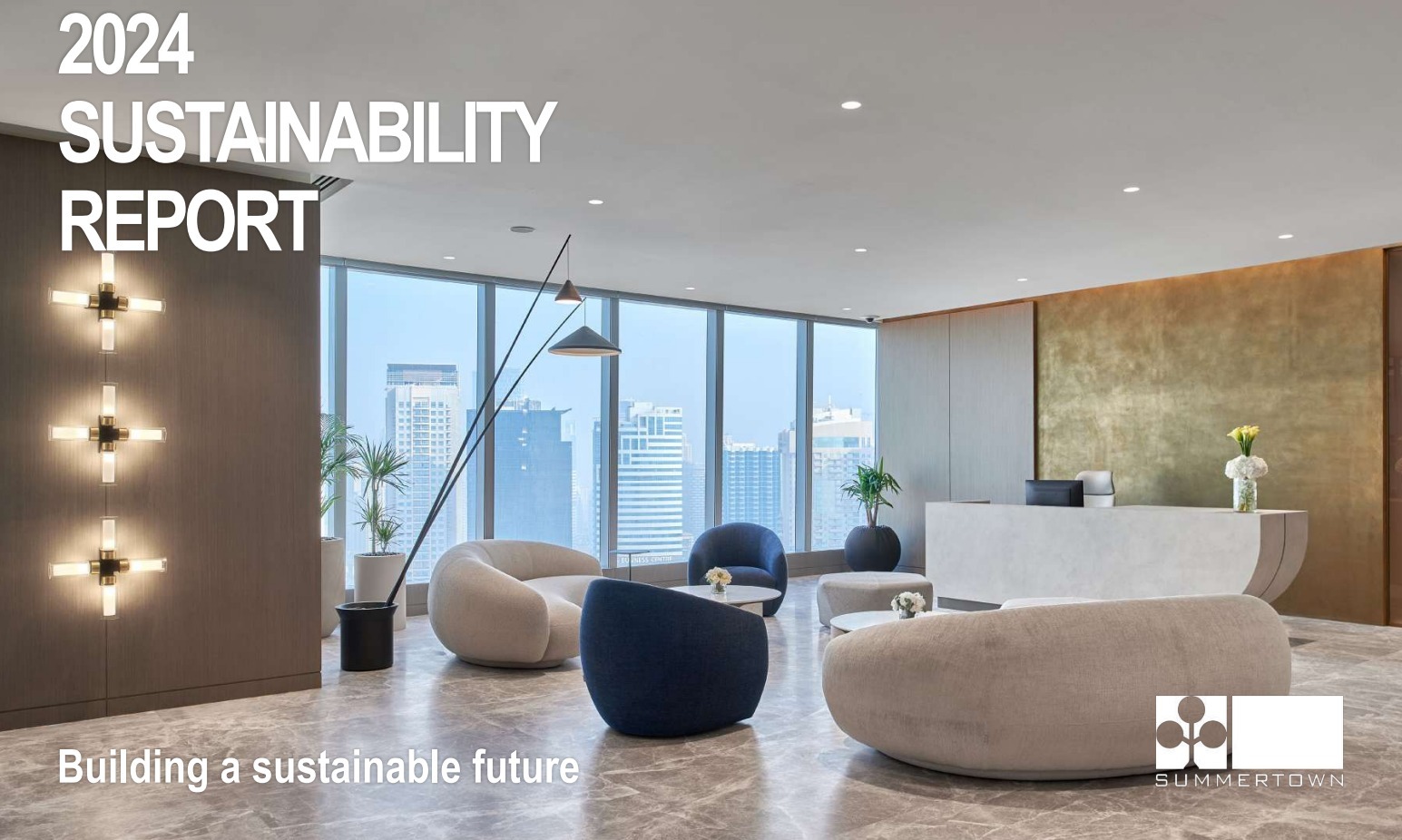Ultimately, the circular economy is about rethinking everything, including business models themselves so that we can reduce consumption. It is a clever idea as it not only reduces the amount of raw materials needed for a growing global population to live vibrant healthy lives but can also reduce carbon emissions and water use during the production of the goods we all buy. [1]
What You Need to Know about the Circular Economy
Since at least the Industrial revolution of the 18th century, our economic model has been a linear one, based on the presumption of continuing growth. This traditional capitalist model is based on a make-use-dispose cycle. In the 21st century, things look a lot different. The impacts on the environment of unsustainable and unchecked economic development are having serious environmental consequences, threatening the very economic systems which gave rise to them.
There is a growing recognition among governments, businesses and consumers around the world, that the way we do things is not sustainable. New thinking about the economy and the environment is needed. The circular economy is one approach that has been proposed. It represents a paradigm shift away from a purely consumption-based: make use toss model to one that is more circular. It proposes a new economic model based on more sustainable business practices and better management of our natural resources. The objective of the circular economy is to reduce the consumption of non-renewable resources; to develop designs and products that cut down on waste, and to expand the useful life of products, and instituting recycling and re-use. Proponents argue that this type of economic model will enable businesses to continue to generate profits, while reducing harmful impacts, such as carbon emissions, pollution and so on.
Basically, at its heart, the circular economy is one in which materials are kept in circulation for as long as possible. Allowing them to be used again and again. [2]
There are many definitions of the circular economy. One simple definition defines it as “…an economic system of closed loops in which raw materials, components and products lose their value as little as possible, renewable energy sources are used and systems thinking is at the core.” [3] In our traditional linear economy, we take-make-use-dispose – without taking into consideration how much resources we use, or pollution/wastage we generate. A circular economy changes this logic, focusing on reusing products and raw materials; reducing waste and preventing harmful emissions to soil, air and water as much as possible. This is termed “closing the loop”. [4]
Image Source: PBL Netherlands Environmental Assessment Agency
A circular economy is based on the principles of designing out waste and pollution, keeping products and materials in use, and regenerating natural systems. [5]
(To learn more about the Circular Economy, visit Ellen MacArthur Foundation)
UAE Circular Economy Initiatives
The UAE government is a signatory of all the major global environmental initiatives. The UAE not only promotes environmental issues globally but has embedded strict environmental targets within its federal plans. Abu Dhabi, Dubai, Sharjah and Ras Al Khaimah have also instituted rigorous environmental objectives.
Image Source: UAE Sustainability Initiatives by Emirates Green Building Council
So, it is not surprising that in April 2019, the UAE became the first country to embrace the World Economic Forum’s Scale 360 initiative. This initiative promotes adopting a circular economy model to address climate change. [6]
Thani Bin Ahmad Al Zeyoudi, Minister of Climate Change and Environment, stated that the UAE’s pledge to develop circular economy confirms the UAE’s standing as a global and open laboratory for economic and technological innovations. It is also fully in accord with UAE Vision 2021 and the Centennial Strategy 2071. The Scale 360 initiative is based on using the latest technologies, including AI and IoT to help design recyclable and reusable goods, reduce waste and protect the environment. The UAE government Omar bin Sultan Al Olama, UAE minister of state for artificial intelligence, said: “Artificial Intelligence is a major contributor to the sustainable development efforts and recycling initiatives. We seek to emphasise the need to adopt artificial intelligence in development strategies.” [7] The government has already pledged $1 Million to support an initiative to cut down on pollution.
At the same time, the Ministry of Climate Change and Environment is supporting a coalition of government agencies, NGOs and global and local private companies to advance a circular economy approach. [8] The coalition is launching a pilot project in Abu Dhabi to test the economic and environmental impact of plastic and other packaging materials on the circular economy. It aims at creating a ‘closed-loop recycling model’ for plastic bottles, beverage cartons, and others. The results of this pilot will be used as the basis of recommendations for fast-tracking sustainability initiatives and improving waste management in Abu Dhabi. [9]
Meanwhile, in Ras Al Khaimah, the government is currently using more than 50 tonnes of camel manure daily as fuel in cement production in an innovative use of the concept of the circular economy. The emirate, rather than dumping the waste of the nearly 9,000 camels who reside there, is processing it and giving it to local cement factories to use as fuel. Since the launch of the project in May 2018, more than 100 thousand tonnes of camel manure have been diverted to produce fuel resulting in a savings of around 18 thousand tonnes of carbon emissions and reducing fuel costs for the participating cement factories. [10][11]
The Circular Economy in the Workplace: How to Start Putting the Theory into Practice
What is the Circular Office? The circular office applies the principles of the circular economy to the workplace – focusing on sustainability and resource recovery. The circular office tries to create a comprehensive system that uses resources creatively, reduces waste, controls costs, and reuses/recovers assets. The circular office marries business’ concern, maximising profitability with the need to protect the environment for future generations.
According to the Circular Economy Model Office Guide (CEMO) prepared by New Zealand’s Sustainable Business Network, the basic principles of a Circular Economy Model Office are:
- As many of the existing materials as possible are to be reused in the office fit-out.
- When new materials are required, the supplier must provide an end of life solution (excluding landfill).
- Waste generated must be diverted from landfill, either for re-use or recycling. [12]
The workplace, and in particular the office, is an ideal place to live test the precepts of the circular economy. If a company can implement circular thinking in the office and see the demonstrable benefits, it is more likely to extend these principles to its wider business operations.
How can the thinking behind the circular economy be applied to the workplace? How do we develop a circular office? We have presented in numerous earlier postings the benefits of the “green office” and applying sustainability in fit out. The circular office takes up these guidelines and goes one step further in the attempt to create a comprehensive office development and management system.
Developing a circular economy in your business means cutting down on waste and managing resources consumption in a way that saves money while helping the environment. Office resources and materials are kept in use for as long as possible so that their maximum value is extracted. Then once their useful life is at an end, they are recovered and re-used rather than just disposed of, feeding back into the system. A circular office has to factor in design, procurement, use, maintenance and repair, recycling and remanufacturing all within the same loop/system.
As an example, office furnishings and fittings are priority areas for improvement and they can deliver quick measurable results. To measure the scale of the problem, in the EU alone, 10 million tonnes of furniture are discarded annually by businesses and consumers; most of it ending up in landfills or incinerators. [13] Often office furnishings are discarded because of changes in fashion or branding. Integrating the concept of “cradle to cradle” means that furniture suppliers are not only committed to designing and manufacturing products that are recyclable, and that do not create waste during the manufacturing process, but that provide opportunities for recycling and reclamation. [14] The EU outlines 6 key cycles to make furniture more circular, taking as example the life cycle of an office chair:
- Chair remains a chair
- Maintaining – using preventative maintenance to extend lifespan of the chair
- Repairing – undertaking corrective maintenance
- Reusing: redistributing products by changing ownership – resale, donation
- Chair is transformed
- Refurbishing: remanufacturing the product to expand life span by appearance. E.g. resizing, reupholstering chair
- Repurposing: product is changed into another product. E.g. chair is transformed into table
- Recycling: the product is split into components which are recovered and used as secondary materials for new products. [15]
A circular office then implements an end to end process – from sourcing furniture from circular suppliers, to extending the life span of the furniture, and finally providing for recycling and reclamation.
Business in the Community (BITC), one of the oldest and largest business-led organisations in the UK has championed the transition to a circular economy, launching Circular Office Campaign in 2017 to inspire companies to integrate circular thinking into their offices and systems. BITC has also developed a handy Circular Office Factsheet to guide companies in beginning to design and implement circular thinking in the workplace. We have adapted and expanded on some of the basic suggestions presented by BITC. There are multiple ways to start implementing circular thinking in the office. Numerous opportunities exist from office design and fit out choices, covering employee occupation and use of office supplies and facilities, all the way to procurement and disposal practices.
The Benefits of a Circular Office
1. Healthier working environment: Health & Well-being
- Use of natural and non-toxic materials
- Improved indoor air quality and ventilation
- More efficient use of space enables agile working and helps stimulate employees
(Read more about how to promote Health & Wellbeing in the Workplace through Office Design & Fit out.)
2. Better Resource Management & Cost Control
- Improved water and electricity consumption – including using smart metering to manage consumption and using plumbing fittings and fixtures that cut down on water consumption
- Longer useful life of equipment and furnishings
- Better rates of recycling for office waste
- More efficient consumption of office materials – stationeries and inks/toners
- Reclaiming and re-purposing old office furniture, computers and equipment not only expands their lifespan but maybe a new revenue source if the items can be resold
3. Enhanced Corporate Social Image and Brand
- Implementing a more environmentally proactive business approach will improve a company’s corporate image
- Companies can repurpose, reclaim office equipment, computers and donate them to NGOs, schools, community organisations as part of their CSR initiatives
Creating a Circular Office: Why it Works for Business, Society & the Environment
In an earlier post, we discussed some of the most efficient sustainable workplace practices. In the following, we will be revisiting some of the same recommendations because the circular economy is just a further evolution in sustainability. The circular office means thinking about where your business is in the economic cycle and reflecting on your role both up and down the chain to ensure you are making an impact. For example, if you are promoting recycling at work, there has to be a system to ensure that recycled waste leaves your premises and ends up where it needs to be – organic waste to be composted/ inorganic waste to be recycled (glass, plastic, paper, etc.).
Each business is different. Committing to creating a circular office involves a shift in thinking – from the project (task-based – clear beginning to ending) to a system focused (processes, cycles and feedback loops). As noted above, the circular economy represents a paradigm shift away from the classic capitalist linear economic system.
1. Laying the Groundwork for the Circular Office: Implementing a Sustainable Office Fit Out
Deciding to create a circular working environment for your business is one of the most radical ways that you can both improve working efficiency and contribute to helping the environment. The first step and perhaps the most important is intention and commitment. Deciding to create a circular office means committing to mindful thinking about the many choices and options that go into creating a workplace – not just painting the walls or laying down flooring, but thinking about how work will be carried out and resources used. Sustainable fit out constructs the perfect base conditions in terms of energy and resource consumption for the circular office. Aiming to garner an international environmental certification, such as LEED, ensures that your office fit out is up to standard and uses the latest technologies and processes.
(Check out our handy guide to LEED certification in the UAE).
2. Office Facilities Management: Improving Energy & Water Management
Rationalising the use of precious resources like energy and water is vital in the circular office. A critical part of this is putting in place the necessary systems to monitor and control consumption. For energy that could mean using lighting sensors, smart metering, and high-efficiency lights. For water consumption, that could mean installing more efficient plumbing fittings and fixtures, like ultra-low flow toilets and showerheads, and low-flow aerators that fit on the sink faucets. It also means setting up ways to recycle or reuse water (greywater and process recycling systems).
The role of facility managers is expanded beyond just ensuring proper maintenance and repair to regularly auditing resource use and implementing measures to increase efficiency. Beyond the incalculable benefit, this has for the environment, it will have a quantifiable impact on operating costs.
3. Using Our Resources Better, Longer & More Wisely: Mindful Waste Reduction
There are many actions a company can take to radically reduce the amount of waste being produced including:
a. Reduce paper use throughout the workplace
- Promote digital document sharing
- Ration paper and toner use
- Create a system to incentivise employees for reducing paper consumption (e.g. printer logs per employee or department)
b. “Zero to Landfill” Policy
- Set challenging targets for reducing waste production
- Engage employees in implementing sorting and recycling for all office wastes
- Ensure recycled waste (organic/non-organic) is sent to proper channels either for composting or recycling.
- Develop systems for assessing IT equipment lifespan – and consider lengthening the time before office upgrades
- Develop systems for refurbishing and reselling or donating IT waste
4. Transforming the Workplace: Changing the Way We Work
An office is more than just walls and workstations; it is the people who live, work and produce there. Any circular office has to work on its workers. This means engaging employees and motivating them not just to do their regular jobs, but to help push the circular economy forward. The circular economy paradigm emphasises how everything is connected. This means creating company cultures that reward innovation and sustainable thinking; including developing processes and procedures that promote sustainability and social responsibility. Some of our suggestions include:
- Going digital: encouraging employees to use digital tools for meetings and work
- Instituting work from home days to cut down on transportation
- Promoting alternative transportation e.g. carpooling or electric vehicles
- Encouraging agile working to maximise productive use of office space
5. Changing What, When and How We Buy: A Shift in Procurement & Supply Chain Processes
- Revolutionise Procurement Cycle
- Apply procurement standards that integrate lifespan, sustainability and recycling potential into the decision-making process. For example, buy compostable food packaging, recycled paint, remanufactured furniture and recycled office equipment.
- Make active choices to buy furnishings and fittings that be re-purposed or reclaimed.
- Rent rather than buy; consider and seek out opportunities to lease office furniture or IT equipment rather than buying.
- Create processes for reclaiming and recycling office equipment, including possible resale (new minor revenue stream).
Virtuous Cycles Rather than Vicious Circles
In the UAE, both the government and businesses are increasingly aware of the need to take urgent action to ensure the long-term sustainability of the economy and the environment. It is not an either/or question but an AND. How do we create the conditions for a vibrant and growing economy that sustains and protects precious environmental resources and cuts down on harm? One of the solutions will certainly be applying a circular economic model. Each incremental step or improvement taken by an individual company or business owner will contribute to the overall solution.
A circular office is a great start for any business committed to bringing about positive change for the country, society and its business model. Introducing a circular approach in your workplace can have multiple overlapping advantages, including:
- Saving costs: reducing expenditure on electricity, water and maintenance
- Improving employee health well-being and motivation – with a knock-on effect, increasing productivity and therefore company profitability
- Improving company branding and reputation with customers, suppliers and government agencies.
At Summertown Interiors, we understand how embedding sound sustainable practices into the business model delivers economic, environmental and social value. Our business model is built on sustainability and promoting circular economic practices. We help other companies fit out their workplaces in the most sustainable way considering the overlapping concerns of economic viability, human health and comfort and environmental sustainability.
Contact us today to see how we can help you make the shift to a more sustainable circular workplace.
References:
[1] https://www.pwc.co.uk/who-we-are/corporate-sustainability/environment/waste/going-circular/going-circular—overview.html
[2] IBID
[3] https://kenniskaarten.hetgroenebrein.nl/en/knowledge-map-circular-economy/what-is-the-definition-a-circular-economy/
[4] https://themasites.pbl.nl/circular-economy/
[5] https://www.ellenmacarthurfoundation.org/circular-economy/what-is-the-circular-economy
[6] https://www.chemanager-online.com/en/news-opinions/headlines/uae-signs-circular-economy-plan
[7] https://gulfnews.com/business/uae-first-globally-to-sign-on-world-economic-forums-scale-360-1.63178513
[8] https://www.arabianindustry.com/construction/news/2019/apr/28/abu-dhabi-bodies-commit-towards-circular-economy-6076265/
[9] https://www.constructionweekonline.com/products-services/182075-uae-climate-change-ministry-eyes-plastic-circular-economy-in-abu-dhabi
[10] https://www.thenational.ae/uae/environment/how-camel-waste-is-fuelling-the-uae-s-circular-economy-1.877698
[11] https://gresb.com/adopting-circularity-uae/
[12] https://cdn2.hubspot.net/hubfs/3320613/CEMO%20Guide%20and%20resources/Circular%20Economy%20Model%20Office%20Guide.pdf
[13] https://eeb.org/library/circular-economy-opportunities-in-the-furniture-sector/
[14] https://www.ahrend.com/en/csr/our-circular-approach/
[15] https://circulareconomy.europa.eu/platform/sites/default/files/circular-economy-in-the-furniture-industry.pdf


